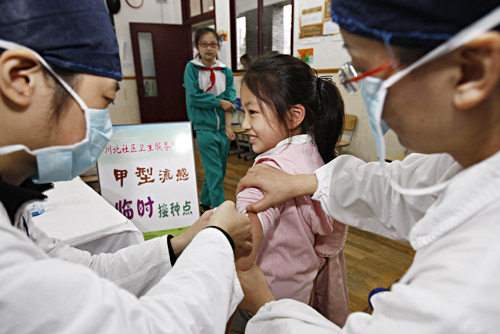|
 |
| FIGHTING BACK: A primary school student in Hongkou District of Shanghai receives the A/H1N1 flu virus vaccination on November 10 (XINHUA) |
Cases of laboratory-confirmed A/H1N1 flu have been rising by several hundred a day since the second half of October on the Chinese mainland as winter approaches. The Ministry of Health (MOH) has warned that the new round of infections will last into next March.
In September, China was the first country to issue a production license to pharmaceutical companies for the A/H1N1 flu vaccine and has launched a mass immunization campaign. But many residents are still hesitating to get the vaccine because they doubt its safety.
The vaccination, though, is one of the most effective ways to prevent and control the A/H1N1 flu epidemic, according to Health Minister Chen Zhu.
In the late 18th century, British doctors found that vaccinating people with cowpox could protect them against the more dangerous smallpox, which was humanity's first step into immunology.
The world has made great strides since the early 20th century to develop effective defenses against microorganisms, said Yin Weidong, the developer of the world's first A/H1N1 vaccine and General Manager of Sinovac Biotech Ltd., a biopharmaceutical company headquartered in Beijing.
The Chinese Center for Disease Control and Prevention enlisted 10,003 people in seven provinces to take part in the world's largest clinical trial of the vaccine. The results showed that 85 percent of the people who received two shots of the vaccine were effectively protected against the virus.
The results of the trials proved that the vaccine is safe, with adverse reaction rates no higher than those seen after the seasonal influenza vaccine is administered. The vaccine's efficiency has also been shown during other international clinical trials, said Chen during an October 30 speech.
"Vaccine research and development in China has made remarkable achievements and has been confirmed by the World Health Organization (WHO). Some countries have shown an interest to purchase our vaccines," said Chen.
Among 13,000 clinical trials, only about 300 people receiving the vaccine had adverse drug reactions (ADR), said Liang Xiaofeng, Director of the Chinese Center for Disease Control and Prevention's vaccination program, during a November 3 press conference.
Liang said China is working with the WHO to improve the still fledgling network that monitors and reports ADRs and again called on all those who had an ADR, such as body aches or fever, to immediately report to the inoculation site.
Quality control for the vaccine is more strict than for other drugs, said Wang Zhijun, Deputy Director of the National Institute for the Control of Pharmaceutical and Biological Products. Wang said 30 other kinds of seasonal influenza vaccines also sometimes trigger an ADR, which can differ in intensity. He said the thrust of their work is to prevent and control severe ADRs.
Approved A/H1N1 vaccines can only be used for the part of the population that is above the age of 3, as clinical trials have so far not included children under that age.
A/H1N1 vaccines are being purchased and allocated by the government, and are being administered to priority demographic groups. Individuals cannot buy the vaccine.
As of November 3, more than 4 million people on the Chinese mainland had been inoculated with A/H1N1 vaccines. About 33.4 million doses of the vaccine had been approved for use as of October 31, of which 26 million had been dispatched to local medical institutions.
To cope with the rising number of A/H1N1 cases, Beijing officials have decided to expand the population certified to be inoculated from previously five groups to all residents. According to Zhao Tao, the disease control section chief of the Beijing Health Bureau, since November 16 all citizens in Beijing have been able to get vaccinated free of charge if they want at 420 stations across the city.
A total of 100 million doses of A/H1N1 flu vaccines will be produced by the first quarter of 2010 based on estimates of the eight domestic vaccine manufacturers' current production capabilities, the MOH said. | 